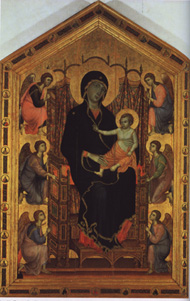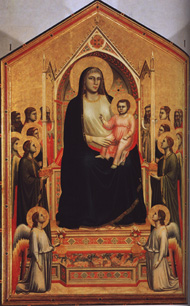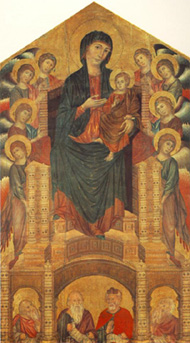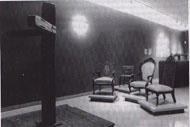


Richard Leppert in his Art and the Committed Eye makes the following important point:
No small part of how we perceive paintings is determined by the various "frames" that surround them. To be sure, paintings, hung on walls are nearly always set within a frame, whether simple or elaborate, which serves to demarcate the image and, not least important, which commonly marks a silent but evident claim to someone's idea (a museum curator, an art dealer, a collector) about the image's relative significance. More to the point, paintings are "institutionally framed," principally by the academy (via the discipline of art history), the museum, and the art market. Images exist within the context of a larger historical process in which all that is in the past is either being forgotten or, if remembered, is recollected in the light of current interests....Images acquire "meaning" not only in relation to their internally specific "contents" and what people choose to say about those contents, but also in part according to where the artworks are exhibited, that is, their physical site.
Leppert is asserting that institutional frames are not neutral, but play a crucial role in constructing meaning. It was long believed that the modern museum practice of isolating works of art on neutral walls was a purer more objective way of displaying objects. But it is crucial to see how this structure is far from neutral and objective, but plays a critical role in constructing meanings. A good example of this is presented by a room in the major Florentine museum the Uffizi. In the first major room one sees on entering the collection are arranged major works of Tuscan art of the late 13th and early 14th centuries. A QuickTime movie of the room is available at the Uffizi site.
 |
 |
 |
|
|
|
Cimabue, Sta. Trinita Madonna, c. 1285. |
The works have been removed from their original contexts as major altarpieces in Florentine churches. Their orginal functions were primarily to be visible manifestations of the essential Christian doctrine of the Incarnation and to be an appropriate backdrop for the celebration of the mass with the central mystery of Christ's True Presence in the Eucharist. Instead now these works are re-deployed in the modern museum to be primary characters in the story of the development of Western Art. Following Enlightenment ideology, the aesthetic is privileged over the religious. The primary position of Giotto's art in this story of artistic and cultural progress is played out in the museum space by having Giotto's painting be the first work one sees in entering the room while the Duccio and Cimabue are placed in subordinate positions flanking the Ognissanti Madonna.. This privileging of late 13th and early 14th century Italian painting is almost universal in modern museum lay-outs. Whether it be the National Gallery in London or the National Gallery in Washington,D.C., the historical sequence of rooms begins with this period. In museums like the Louvre and Metropolitan Museum of Art, this period initiates the painting collections which are given primary position in the museum plans.
This privileged position is also reflected in the traditional, two semester surveys of Western Art. The second semester regularly begins with the art of Giotto. This practice is so well-established that the Revised Edition of Marilyn Stokstad's Art History has added her discussion of Italian Gothic painting to the beginning of the second volume of the paperback version of the text. This was undoubtedly in response to complaints by instructors who were disoriented when this material was deleted in the first publication of the text.
The authority of the work of Giotto in the traditional narratives of art history is reflected in the beginning of Bruce Cole's Giotto and Florentine Painting 1280-1379 which begins with an encounter of these three works in the room in the Uffizi:
As the visitor to the Uffizi Gallery in Florence turns from the long, statue-lined corridor into the first room of the museum, he [sic] sees three enormous, softly glowing paintings --one each by Cimabue, Duccio and Giotto. Whether he know it or not, he is standing before some of the most important works of art in the entire history of Western painting: the pictorial images and ideals of a quarter of a century that was, in its fundamental significance, unique.
Cole analysis of the three works concludes with the following paragraph:
This new visual relationship between spectator and picture, between the divine and human realms, is the creation of Giotto, the Ognissanti Madonna is one of its first greatest manifestations. This picture, and others like it from Giotto's hand, decisively broke the iconic bonds of Italian art, making a return to such mentally and physically removed works as those by Cimabue and Duccio in the same room impossible. But Giotto did more. By creating such convincing illusionism and by humanizing his monumental figures, he set the stage for much of the subsequent development of European art. For hundreds of years artists were to follow along the road he first charted.(pp. 6-7).
The rhetorical strategies employed in this text seem so natural and true to modern art history. Here we see the trope of the central position of "man" overcoming superstition through rational activity, again the aesthetic overcoming the religious. Cole, emphasizes like modern art history, the central role of the artist as individual plays in initiating change. Words like "unique" and "creation" are interwoven through the text. Also established in the text is the parallel between the artist and the viewer who is gendered male and is understood to be the rightful inheritor of this tradition. We are taught to see in the art of Giotto crucial foundations to our modern ideology of liberal humanism.
This example should teach us not to see the museum as a neutral and objective site, but one that not only constructs how we see art, but also, and probably more significantly, plays an important role in defining who we are. In the last generation, there has been a radical reconsideration of the concept of the museum. The distinction between the Modernist and Post-Modernist conceptions of the museum is succinctly articulated in the following passage by Danielle Rice ("Museum Education Embracing Uncertainty," The Art Bulletin ,1995, p. 16:
[In the Modernist ideology], the role of the museum was
to be a neutral but evocative backdrop for the best examples of
human creativity that it could acquire and display. The quality
of the art object was, at this time, firmly grounded in a system
of connoisseurship that celebrated uniqueness, rarity, and participation
in the developmental and exclusionary narrative of the progress
of art that was considered to be the history of art....
Postmodern scholarship eschews the notion of a singular, metanarrative
history of art in favor of multiple narratives and perspectives.
The individual art object, instead of being seen as a pleasing
combination of formal elements, is treated as "an element
of discourse" within a variety of social, cultural, and political
contexts. In contemporary critical thinking, the museum can no
longer claim to be a neutral backdrop for the display of art,
because it is understood instead to be a highly complex institution
which participates in the legitmation of power.... The universality
of the formal language of art....is now seen as a particular ideology
which upholds the structuring of authority.
It is important to understand that this idea of the museum that developed at the end of the late eighteenth century and is still evident today is not absolute. Other alternatives can be developed. The history of the museum in Western culture makes us aware of how historically limited our modern concept is. Consider these three other alternatives: the Princely Collection, the Wunderkammer, and the Connoisseur's Collection.
In reading Chapter 5 of John Berger's Ways of Seeing think of the implications of what Berger has to say about art and possession in relationship to the following image by Fred Wilson entitled Furniture with Whipping Post:
